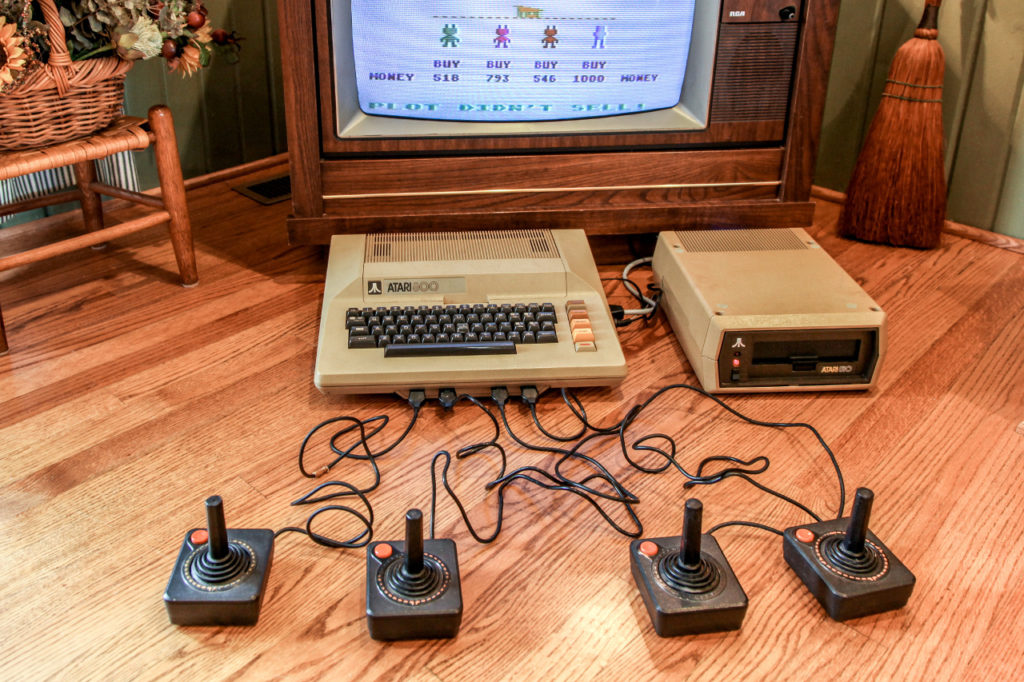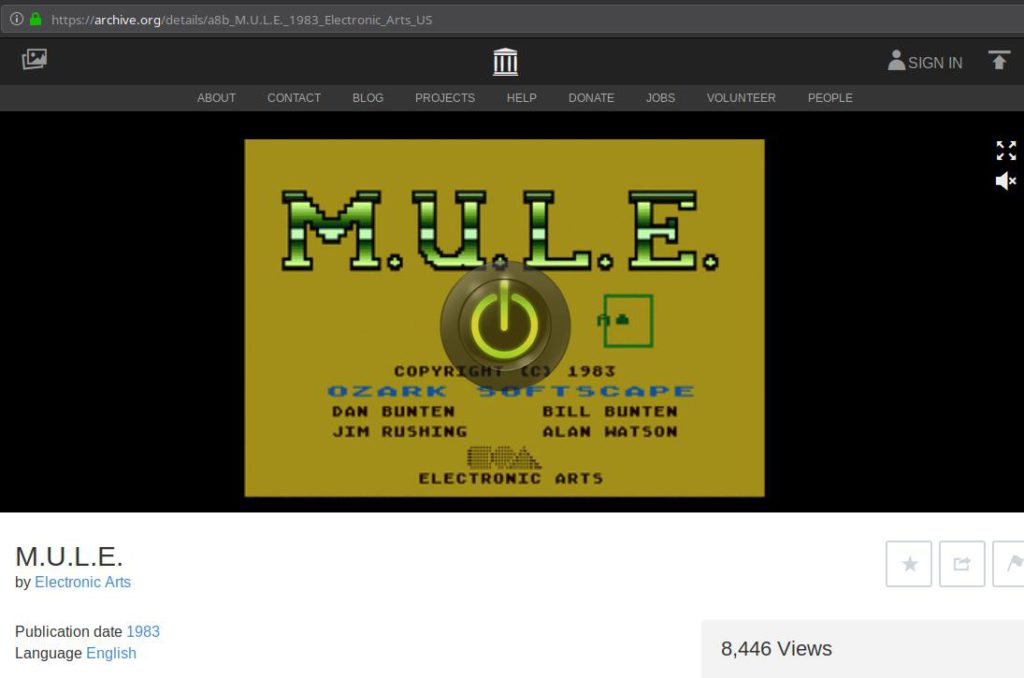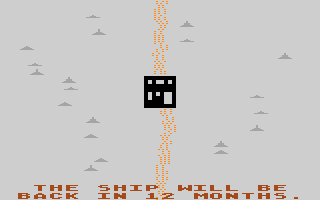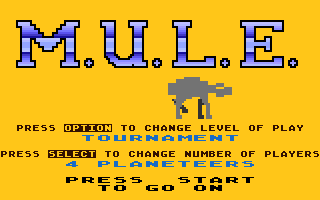Author: Goethe
To discuss this version of M.U.L.E., please use this topic in the WoM forum.
This article is still work-in-progress. I don’t know if I will ever finish it. 😉
Introduction
If you don’t know anything about M.U.L.E. yet, I suggest you read the General introduction to the M.U.L.E. legacy first.
This article discusses the version of M.U.L.E. developed for Atari 48K Home Computers (Atari 400/800). In the following picture, a typical setup of this version is seen, recreated in 2015 by the PCWorld magazine (Awesome, guys!)

M.U.L.E. was originally developed and released for the Atari 48K Home Computers in 1983. The Commodore 64 version followed afterwards. Both versions of M.U.L.E. are considered to be the “original” versions of M.U.L.E., because they were developed by the original Ozark Softscape developer team (Dan Bunten, Bill Bunten, Alan Watson, Jim Rushing, Roy Glover). All subsequent ports of the “original” M.U.L.E. (see other Classic M.U.L.E. games) were developed by different developer teams.
“Original” or “original original”, and does it make a difference?
The Atari 48K version is the “original original” version, because it was developed and released before the Commodore 64 version.
One has to know: Among M.U.L.E. fans, there is an age-old bickering going on with regard to which of the two original versions (Atari and Commodore) is the “better” one. With this report, I will try to stay as objective as possible. I really don’t want to fuel this bickering… Therefore, the “Gameplay” section focuses on describing the differences between the Atari and Commodore versions objectively.
Though the differences of the two versions are significant, the similarities are more significant. Which version you prefer is very much a matter of taste, not a matter of objectivity; and even more a matter of nostalgia, a matter of which version you grew up with. Personally, though I grew up with the Commodore version, meanwhile I think both versions are awesome. If you grew up with any of them, you can consider yourself extremely lucky! So, to conclude the bickering once and for all, the only things I want to say are:
- To the Atari fans: Awesome game, but please don’t bash the Commodore version fans – their version is awesome too!
- To the Commodore fans: Awesome game, but please don’t bash the Atari version fans – their version is awesome too!
- To the Atari fans: But the Commodore version is definitely the better one! 16K more, ’nuff said! 😉
- To the Atari and Commodore fans: Have you played the IBM PCjr version yet? This is the most awesome one! At least if you are deaf…
Who knows… Maybe one day, we will see an amalgamation of the two code bases (Atari and Commodore)… Or even an amalgamation of three code bases: The rare and little know IBM PCjr version of M.U.L.E. is extremely faithful to the original Atari and Commodore versions, nevertheless introduces some cool new features to the game, like for example the option to play more than 12 rounds.
Insights from the development team
During the many years I research and collect “all things M.U.L.E.”, I have decided that it is time to write an “executive summary” of all the interesting bits and pieces I found.
- “Executive Summary” of M.U.L.E. insights from the original development team
- Complete, detailed list of M.U.L.E. insights from the original development team
How to play this game today
The quickest way play the game is to make use of the Archive.org Atari 8-bit software library. Archive.org hosts a web-based Atari emulator running directly inside your internet browser. However, you can’t use a joystick (or even four), so you have to play with the keyboard.
Link: https://archive.org/details/a8b_M.U.L.E._1983_Electronic_Arts_US

The other options are the following. In order not to clutter this page too much, I have moved the content to separate pages:
- Emulating Atari M.U.L.E. on modern PCs. Even internet online play is possible, if you are a bit versed in computer and network administration.
- Emulating Atari M.U.L.E. on a Sega Dreamcast for local four-player, four-joypad fun. The Sega Dreamcast is an ideal machine for this because of it’s built-in four joypad ports.
Gameplay
to be done
Gameplay comparison with Atari/Commodore M.U.L.E.
On the Atari 800…
- …the Wampus seems to be more volatile (jumping between mountains more often), which makes it harder to catch. But you can catch it even on the topmost row of mountains, which is not possible on Commodore 64
- …the placement area of equipping a plot with a MULE seems to be a little smaller than on the C64, resulting in more M.U.L.E.s running away when (trying) to equip them on plots
- …during the auctions you only have to make one step up or down to reach the initial buy or sell line, whereas you have to make two steps on the C64
- …the time limit feels tougher. On the Atari it is very rare that I can equip three plots on the planet during one turn, whereas it is very common on the C64.
- …the “Planetquake” event is much tougher, because mountains are shifting, causing two M.U.L.E.s to be destroyed. That is especially gruesome early on in the game.
- …it is possible to drive the colony score to astronomical heights during the month 12 auction, when two human players collude. That is not possible on the C64.
Reception
Contemporary reviews (in the 1980’ies)
- 1983, July-August
- 1983, September
- 1984, March
Modern reviews
Personal stories
- 2019, February
- 2015, November
Trivia
- Together with the Commodore 64 version, only about 30.000 units were sold. Piracy is to blame. In his 2015 interview, Alan Watson said that only one in 12 copies of M.U.L.E. were original, the rest pirated.
- The rumor that the Atari version only has 128 playing fields is untrue. Both Atari and C64 versions have the same random playing field generator. The rumor was persistent for many years, and was acutally debunked in the early 2000’s when Kroah reverse-engineered the Atari code (link to be added). The rumor was based on a statement of unknown origin (if anyone can find a written quote for this, please let WoM know!)… It said that Anne Westfall (co-creator of Archon) once claimed that she was very good at M.U.L.E. because she “could memorise all the 128 different playing fields” of the game.
Downloads, Galleries and Hyperlinks
Downloads:
 Atari 400/800 M.U.L.E. Disk Image (35.5 KiB, 406 hits)
Atari 400/800 M.U.L.E. Disk Image (35.5 KiB, 406 hits)
Box art gallery:
- to be done
Screenshot gallery:


Hyperlinks:
- Atari M.U.L.E. playable, emulated on Archive.org
- last checked working in January 2019
- MobyGames entry for Atari M.U.L.E.
- last checked working in January 2019
- Wikipedia entry for M.U.L.E. (agnostic of version)
- last checked working in January 2019
- AtariMania entry for Atari M.U.L.E.
- last checked working in January 2019
External media
Full multiplayer gameplay video of Atari 48K version on Vimeo:

